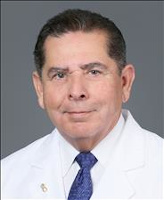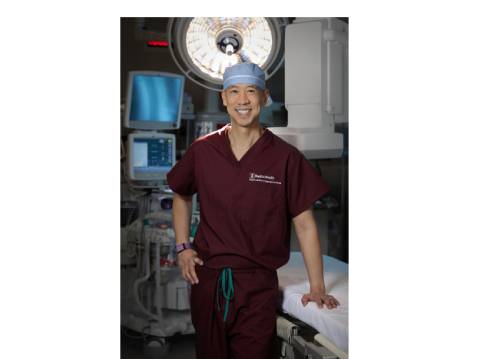
Education
Innovative Oxygen Therapy Limits Damage from Heart Attacks
4 min. read
Baptist Health Miami Cardiac & Vascular Institute
“I told my wife to dial 911,” says Nelson De Jesús, 52, recalling the day in late April when he wound up in the emergency room at Baptist Health Baptist Hospital. “It was about 6:30 in the morning and I was getting ready to go to work. All of a sudden, I felt this discomfort in my chest.” The hospitality management executive and father of two says he knew right away he was having a heart attack. “I looked at my wife and said, ‘I think I’m going to die.’”
(Watch now: Nelson De Jesús recalls his near-fatal heart attack and how the experts at Miami Cardiac & Vascular Institute used an innovative oxygen therapy to save his life. Video by Alcyene de Almeida Rodriguez.)
When he arrived at Baptist Hospital, Mr. De Jesús was still conscious but suffering from an “anterior wall myocardial infarction, or heart attack, in which the artery to the front of his heart was closing down,” according to Ramon Quesada, M.D., director of Interventional & Structural Cardiac Innovations and Research at Baptist Health Miami Cardiac & Vascular Institute.
While in the ER, Mr. De Jesús went into ventricular fibrillation, meaning his heart was unable to pump blood to the rest of the body. Without rapid treatment, he would be dead within minutes. He was immediately moved to Baptist Health’s Cath Lab (cardiac catheterization lab) where he underwent a coronary angiography.
“We have a heart attack team standing by 24/7 at Miami Cardiovascular Institute,” says Dr. Quesada. “Our goal is to get the patient open within 60 minutes of suffering a heart attack.” Mr. De Jesús’ angiogram revealed he had a “very complex 95 to 99 percent occlusion of the left anterior descending (LAD) artery.”

Ramon Quesada, M.D., director of Interventional & Structural Cardiac Innovations and Research at Baptist Health Miami Cardiac & Vascular Institute
Branching off of the left main coronary artery, the LAD is the largest coronary artery, circulating oxygenated blood throughout the heart and body, Dr. Quesada explains. It is the circulatory system’s “main highway,” providing 50 percent of the heart muscle’s blood supply.
“That’s why we call these types of heart attacks ‘widowmakers’ – they’re the most severe type,” says Dr. Quesada. “Immediate treatment is crucial for the patient’s survival. If blood flow is not reestablished quickly, the heart can sustain extensive and irreversible or even fatal damage.”
A new way to restore blood flow to the heart
To help preserve precious heart muscle, Dr. Quesada employed an innovative therapy designed to boost oxygen flow to the heart’s microcirculation, the network of tiny vessels surrounding the muscle. “First, we open the artery and place a stent in the main vessels, then we infuse super-saturated oxygen (SSO2) through the coronary artery for one hour,” he explains.
According to Dr. Quesada, SSO2 contains a much higher concentration of oxygen than that of normal blood and is delivered directly to the heart to recover damaged tissue. “SSO2 therapy is essential to helping restore blood flow to the microcirculation,” he says. “Without it, the blood gets stagnant and doesn’t flow to the microcirculation, so damage to the heart muscle is going to be substantial,” he says.
Studies have shown that SSO2 therapy “is associated with lower rates of heart failure and death within one year,” and is effective only if delivered within six hours of symptom onset. SSO2 therapy is also the only therapy approved by the FDA to “reduce infarct size,” or the extent of tissue damage caused by the heart attack. “The more muscle you save, the better outcome you’re going to have,” Dr. Quesada says.
Mr. De Jesús was a perfect candidate for the new therapy, Dr. Quesada says. “After one hour of SSO2 therapy, he was stabilized and his heart was beating normally. His microcirculation improved dramatically and just three days later his heart muscle was almost completely normal. Now he’s totally asymptomatic and living a normal life."
A wake-up call taken seriously
Following his near-death experience, Mr. De Jesús says he’s “thankful to be here” and “grateful to have a second chance.” He says his heart attack was a wake-up call, and one he has taken seriously.
“Sometimes we just get caught up in the daily demands of life and work and we end up neglecting ourselves,” Mr. De Jesús observes. “Now, I’ve changed all my ways and I feel great. I’m exercising five times a week and I’ve dropped 34 pounds, down from 210.” In his free time, he’s back to enjoying his love of the outdoors, which he says includes golfing, boating, fishing and camping.
Mr. De Jesús recognizes that things could have ended very differently if not for the “all hands on deck” response by Dr. Quesada and his team at Miami Cardiac & Vascular Institute. “It was a pretty scary and tense moment, for sure,” he admits. “But the reason I’m here today is because of that new therapy, and everything being done so quickly. It was amazing.”
Healthcare that Cares
Related Stories
View All Articles
What Exactly is ‘Cardiovascular Kidney Metabolic Syndrome’ and Why It’s So Important
March 28, 2024
3 min. read

New Hybrid Endovascular Suite Offers Care for Complex Cardiovascular Conditions
March 26, 2024
2 min. read

New Surgeon Leader for Baptist Health Miami Cardiac & Vascular Institute Plans Major Expansion
March 4, 2024
4 min. read